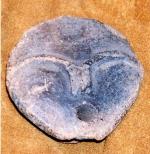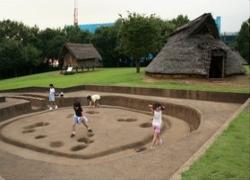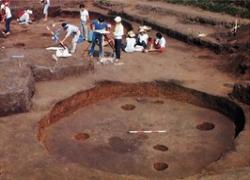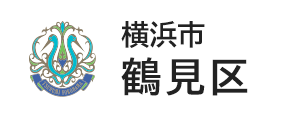- Yokohama-shi Top Page
- Tsurumi Ward Top Page
- Introduction of the ward
- Overview of Tsurumi Ward
- History of Tsurumi Ward
- 24th: Ancient man who wakes up asleep
The text is from here.
24th: Ancient man who wakes up asleep
Last updated on January 29, 2020.
The Tsurumi River basin is a treasure trove of tombs

A person excavated from the Komaoka Donomae Tumulus Haniwa "History of Tsurumi and People's Life" from the collection of the Tokyo National Museum.
The Tsurumi River basin is said to be a treasure trove of ancient tombs.
There are many hills in Tsurumi Ward, including the Komaoka Hyotanyama Burial Mounds excavated by Dr. Shogoro Tsuboi in 1907, the Komaoka Donomae Burial Mounds excavated by Dr. Haniwa, the Kajiyama Burial Mounds including Kabutozuka, and the Suwazaka keyhole-shaped kofun, where straight swords and iron armor were buried inside the sarcophagus.
Most of the artifact, which conveys the lives and culture of ancient people, including Haniwa, pottery, stoneware and balls excavated from ancient tombs, is owned by the Tokyo National Museum and the Kanagawa Prefectural Museum.
Yayoi period's human earthenware
In the ward hall on the first floor of the Tsurumi Ward Hall, there is a display of almost complete human-faced pottery from the late Yayoi period (around the 5th to 3rd centuries BC) (upper left photo).
The pottery was excavated from the site of Kami-Taipei (Tsurumi Ward Sueyoshi) in 1978 (Showa 53) as part of a project to publish Tsurumi Ward History, compiled to commemorate the 50th anniversary of the Tsurumi Ward System. During the summer vacation period from July 24 to August 12, a total of 1,000 people from the local community, including junior high school students, high school students, and university students, also confirmed six pit-type dwellings in Yayoi period.

Exhibited at the Tsurumi Ward Hall Hall, a human-faced pottery excavated at the Kamisueyoshi Kamidai archeological site owned by Kingo Yokoyama and Kanagawa Prefecture Important Cultural Property
Jomon period's human face handle
In 1941 (Showa 16), Tsurumi Junior High School (former junior high school / current prefectural Tsurumi High School) was discovered at the construction site of Tsurumi Junior High School (formerly junior high school / current prefectural Tsurumi High School).
Shigeyuki Matsui, a sixth-year student at Market Elementary School at the time, discovered the almost complete human handle.
Matsui, who was interested in archeology because he was fascinated by the sentence "Ancient Relics" in a Japanese language textbook, read "Introduction to Archeology" and expanded his dreams for ancient times. After school, he walked around the hills of Mitsuike and Sueyoshi almost every day in search of earthenware with arrowheads and rice husks. The hills where Matsui Shonen walked are the Kosenzuka Kaizuka and the Uedai / Kami Taipei archeological site.
One day, at a land reclamation work site at Tsurumi Junior High School, I found a piece of pottery falling silently. It was a rare piece of pottery in the shape of a person's face, so I took it home with care and preserved it separately from other pottery.
The pieces of the pottery were dissipated by some time, but only the pottery in the shape of the human face was preserved carefully. However, for half a century after his discovery, Matsui himself had forgotten his existence.

A human-faced pottery discovered in 1941 by Shigeyuki Matsui, a sixth-grade elementary school student, near Kosenzuka Kaizuka in 1941.
The trigger was the inhabitant of a ward cultural festival
It was in November 1993 (1993) that Matsui's human pottery awakened again from deep sleep. The 14th Tsurumi Ward's cultural festival Local History Exhibition.
Matsui, who came to see an acquaintance's book in cultural festival, recalls a piece of rare earthenware collected during his boyhood by looking at photographs of the Tsurumi History Society's local history exhibition "History and Life of My Town Series Sueyoshi, Kajiyama, Komaoka and Shishigaya."
"In fact, I have a pottery with a person's face that I found when I was a child.……」
Minoru Ito, then chairman of the Tsurumi History Society, who was revealed by Matsui, consulted with Masayoshi Miyake, a local historian and archeologist who participated in the excavation of the Kami-Taipei archeological site and confirmed the pottery of Yayoi period.
Mysterious and relaxed expression
In December, several people, including Professor Miyake, Chairman Ito, and officers of the Tsurumi History Society, visited Matsui's house and met mysterious pottery reminiscent of Munch's "scream".
70mm in length and 75mm in width, the ancient messenger still seemed to not wake up from deep sleep, but his eyebrows were beautiful, with a mouth that appealed something, and innocent, with a mysterious expression that attracted the viewer to the home of the soul. Miyake said, "This is a human-faced handle, which is older than Yayoi period's human-faced pottery found at the site of Kami-Taipei, and I believe it is from the late Jomon period about 3,000 years ago."

Illustration of human face handle, Isamu Yoshizawa's drawing
Message from Ancient People "The Heart of Prayer"
Miyake explained, "The details will be elucidated by experts, but it seems to be valuable historically."
"I think the human-face handle was decorated like a decoration on the front of the earthenware, and was used as a celestial object to the worship of the people of Jomon period, rather than a decoration of a vessel for putting things into things."
"Some earthenware handles and clay figurines resemble animal surfaces such as snakes and wild boars, but it is rare to have a person's face."
"The outline is also marked with a mortar-era Jomon pattern, and the surface of the surface is carefully finished with makeup clay. On the cheek part, there is also a pattern with a half-cut bamboo knot of bamboo divided into two, and the height of the hierarchical technology and culture of the people at that time can be extended."
He concluded, "I think this human handle may have a feeling of respect for the nature of ancient people and a heart of prayer for God."
Mr. Okuma said, "It is said that this is the age of mind now, but I think we must take the message from the ancient people entrusted to this human handle devoutly." Was.
Twelve years since then, where, who, who and what are the human handle that conveyed the breath of ancient times?
If there was a local museum in Tsurumi Ward, the slept ancients would tell us more.……。
There was also a Yayoi-style village in the hills of Tsurumi!

Yayoi-style village of Otsuka, Saikatsudo archeological park
Photographed in the summer of 2006

Excavation of the archaeological site in Taipei in the summer of 1978
From "History of Tsurumi and People's Life"
Inquiries to this page
Tsurumi Ward General Affairs Department Ward Administration Promotion Division
Phone: 045-510-1680
Phone: 045-510-1680
Fax: 045-510-1891
E-Mail address [email protected]
Page ID: 466-060-190













